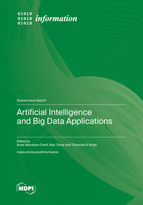Artificial Intelligence and Big Data Applications
A special issue of Information (ISSN 2078-2489). This special issue belongs to the section "Information Processes".
Deadline for manuscript submissions: closed (30 December 2023) | Viewed by 27696
Special Issue Editors
Interests: software ambient intelligence; sementicsemantic knowledge representation; software quality
Special Issues, Collections and Topics in MDPI journals
Interests: VANETs; big data; artificial intelligence
Special Issue Information
Dear Colleagues,
This Special Issue will present extended versions of selected papers presented at the 3rd International Conference on Machine Intelligence and Data Science Applications (MIDAS-2022), which will be held on 7 and 8 December 2022, at the University of Versailles, Paris Saclay, France. MIDAS-2022 aims to promote and provide a platform for researchers, academics, and practitioners to meet and exchange ideas on recent theoretical and applied machine and artificial intelligence and data sciences research. The conference targets the theme of machine intelligence and its applications. A wide range of works with comprehensive information on image processing, natural language processing, computer vision, sentiment analysis, voice and gesture analysis, and other topics are invited to the conference. The latest works in multidisciplinary applications such as legal, healthcare, smart society, cyber physical systems, and smart agriculture, among others, are also invited. The conference will be of interest to computer science engineers, machine intelligence lecturers/researchers, and engineering graduates. The conference program consists of a wide range of sessions including distinguished lectures, paper presentations, and poster presentations, along with prominent keynote speakers and industrial workshops. The theme for the conference is apt to the present scenario as the world is currently driven by data, and human interference is being limited by using various AI technologies. Authors of invited papers should be aware that the final submitted manuscript must provide a minimum of 50% new content and not exceed 30% copy/paste from the proceedings paper.
Prof. Dr. Amar Ramdane-Cherif
Dr. Ravi Tomar
Dr. Thipendra P Singh
Guest Editors
Manuscript Submission Information
Manuscripts should be submitted online at www.mdpi.com by registering and logging in to this website. Once you are registered, click here to go to the submission form. Manuscripts can be submitted until the deadline. All submissions that pass pre-check are peer-reviewed. Accepted papers will be published continuously in the journal (as soon as accepted) and will be listed together on the special issue website. Research articles, review articles as well as short communications are invited. For planned papers, a title and short abstract (about 100 words) can be sent to the Editorial Office for announcement on this website.
Submitted manuscripts should not have been published previously, nor be under consideration for publication elsewhere (except conference proceedings papers). All manuscripts are thoroughly refereed through a single-blind peer-review process. A guide for authors and other relevant information for submission of manuscripts is available on the Instructions for Authors page. Information is an international peer-reviewed open access monthly journal published by MDPI.
Please visit the Instructions for Authors page before submitting a manuscript. The Article Processing Charge (APC) for publication in this open access journal is 1600 CHF (Swiss Francs). Submitted papers should be well formatted and use good English. Authors may use MDPI's English editing service prior to publication or during author revisions.
Keywords
- computational intelligence
- cognitive intelligence
- intelligent systems
- ambient intelligence
- deep learning
- data analytics and optimization
- data pre-processing
- big data analytics
- soft computing
- evolutionary computing
- predictive analysis








